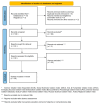The Unfulfilled Potential of Synthetic and Biological Hydrogel Membranes in the Treatment of Abdominal Hernias
- PMID: 39727512
- PMCID: PMC11675378
- DOI: 10.3390/gels10120754
The Unfulfilled Potential of Synthetic and Biological Hydrogel Membranes in the Treatment of Abdominal Hernias
Abstract
Hydrogel membranes can offer a cutting-edge solution for abdominal hernia treatment. By combining favorable mechanical parameters, tissue integration, and the potential for targeted drug delivery, hydrogels are a promising alternative therapeutic option. The current review examines the application of hydrogel materials composed of synthetic and biological polymers, such as polyethylene glycol (PEG), polyvinyl alcohol (PVA), gelatine, and silk fibroin, in the context of hernia repair. Overall, this review highlights the current issues and prospects of hydrogel membranes as viable alternatives to the conventional hernia meshes. The emphasis is placed on the applicability of these hydrogels as components of bilayer systems and standalone materials. According to our research, hydrogel membranes exhibit several advantageous features relevant to hernia repair, such as a controlled inflammatory reaction, tissue integration, anti-adhesive-, and even thermoresponsive properties. Nevertheless, despite significant advancements in material science, the potential of hydrogel membranes seems neglected. Bilayer constructs have not transitioned to clinical trials, whereas standalone membranes seem unreliable due to the lack of comprehensive mechanical characterization and long-term in vivo experiments.
Keywords: bilayer membranes; in vivo studies; mechanical studies; surgical meshes; tissue engineering.
Conflict of interest statement
The authors declare no conflicts of interest.
Figures









References
-
- Revete A., Aparicio A., Cisterna B.A., Revete J., Luis L., Ibarra E., Segura González E.A., Molino J., Reginensi D. Advancements in the Use of Hydrogels for Regenerative Medicine: Properties and Biomedical Applications. Int. J. Biomater. 2022;2022:3606765. doi: 10.1155/2022/3606765. - DOI - PMC - PubMed
-
- Jenkins J.T., O’Dwyer P.J. Inguinal hernias. BMJ Br. Med. J. 2008;336:269. doi: 10.1136/bmj.39450.428275.AD. - DOI - PMC - PubMed
-
- Lindenbergh K.C., van Duinen A.J., Ahlbäck J.G., Kamoh J., Bah S., Ashley T., Löfgren J., Grobusch M.P., Sankoh O., Bolkan H.A. Prevalence, Incidence, Repair Rate, and Morbidity of Groin Hernias in Sierra Leone: Cross-Sectional Household Study. BJS Open. 2023;7 doi: 10.1093/bjsopen/zrac158. - DOI - PMC - PubMed
Publication types
LinkOut - more resources
Full Text Sources
Miscellaneous

